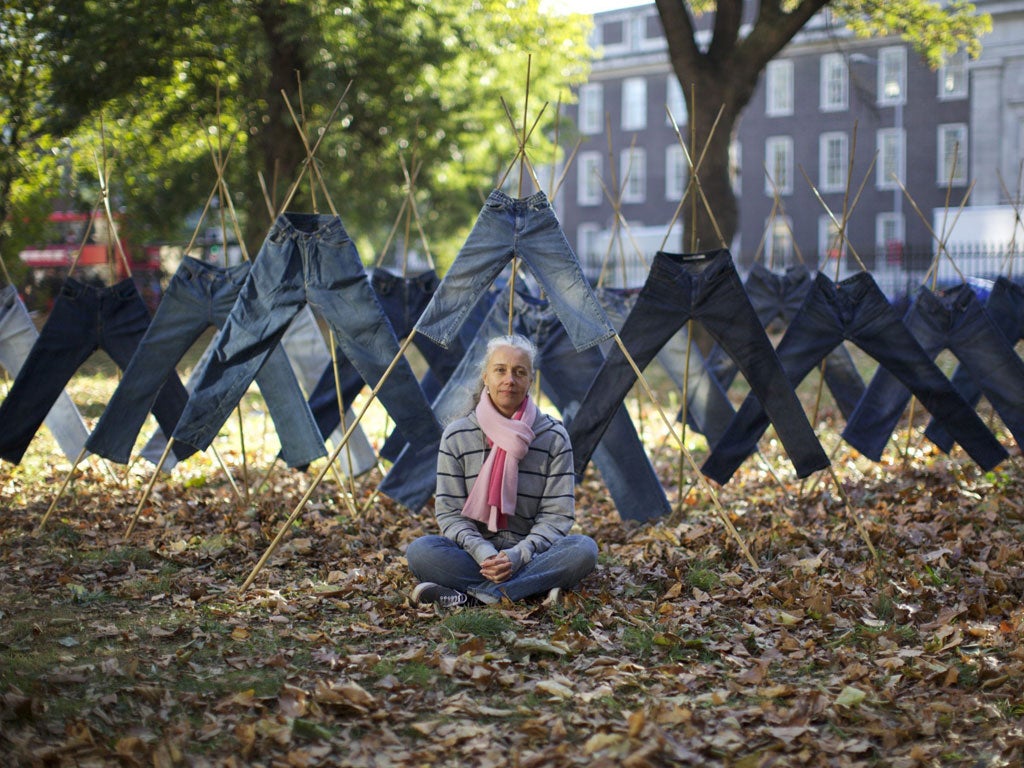Does my bum look big in my catalytic converter?
Introducing jeans and dresses that can help save the environment

Some people wear their heart on their sleeve. Now a few may take to wearing their eco-credentials too, in the form of jeans that work the same way as catalytic converters in cars.
The catalytic jeans are the brainchild of the chemist Professor Tony Ryan and the fashion designer Professor Helen Storey, who discovered that when denim is covered with tiny particles of a mineral called titanium dioxide, it reacts with air and light to break down harmful emissions in the air.
Nitrogen oxide (NO2) pollutants – produced mainly by traffic and factories – are then neutralised and simply washed away when the garment is laundered.
So in theory, jeans wearers of the future could help to clean the dirty air around them simply by walking about in their favourite pair of Wranglers or Levis.
With toxic emissions killing an estimated 1.3 million people a year worldwide, the resulting improvement in air quality could significantly reduce deaths and respiratory illnesses such as asthma.
Professor Storey, of the London College of Fashion, was the enfant terrible of fashion 20 years ago, renowned for dressing stars such as Madonna and Cher. Her designs bore shock images, including one of a foetus, and in 1995 she caused a furore by sending bare-bottomed models down the catwalk.
But in 2004 her life changed when, through her biologist sister, she "re-discovered science" and had a meeting of minds with Professor Ryan, from Sheffield University. The pair started working on a green science and fashion collaboration called Wonderland, which developed into Catalytic Clothing. Their eureka moment came when they realised that microscopic particles of titanium oxide, which is contained in glass, paving stones and sun cream, worked as a pollution-buster when sprayed on clothes.
They found that the particles were able to grip on to the millions of fibres in the material and had a greater effect due to the constant movement of the fabric while being worn. This is because titanium oxide needs light and airflow to catalyse and turn noxious gases into harmless, water-soluble nitrates.
Professor Storey said: "It seemed to be particularly effective on denim jeans and then we realised there were more denim jeans on the planet than people.
"So even if we could only get it to work on denim we could achieve quite a lot in terms of what the technology could do for the world."
The pair are attempting to turn their idea into a mass-market product. They have been working with the detergent firm Ecover to produce a laundry additive called CatClo that could be put in washing powder or fabric conditioner.
Professor Ryan said: "If thousands of people used the additive, the result would be a significant improvement in air quality. In Sheffield, for instance, if everyone washed their clothes in the additive, there would be no more pollution caused by nitrogen oxides."
He added that the product is currently undergoing safety tests, but so far there is no evidence it poses a threat to human skin or water supplies.
Catalytic Clothing has been exhibited at science and fashions shows to spread the word, and a short film about the technology featuring model Erin O'Connor has gone viral across the web. The professors hope that CatClo will be on sale in the high street within the next two years.
Green wear
Cigarette butt clothing
Chilean designer Alexandra Guerrero discovered that purified dog-ends can be crafted into a durable clothing material. The clothes can be bought via the web.
Solar-powered bra
A bra generating enough electric energy to charge a mobile phone, was unveiled in Japan, but the idea of walking round in an exposed bra never caught on.
Recycled pet fur
A professional cat groomer from South Carolina, Danelle German, found that cat fur clippings could be cured, spun into yarn and knitted into handbags.
Eco-friendly jeans
A Brazilian company, Tristar, unveiled a new line of eco-friendly jeans, which could be cleaned by simply putting them in the freezer.
Thermo-electric wellies
Orange created Orange Power Wellies, boots fitted with a "power-generating sole" that converts heat from your feet into an electrical current to charge a mobile phone.
Catalytic Clothing's Field of Jeans will be exhibited at the Manchester Science Festival, 27 Oct to 4 Nov, manchestersciencefestival.com
Subscribe to Independent Premium to bookmark this article
Want to bookmark your favourite articles and stories to read or reference later? Start your Independent Premium subscription today.

Join our commenting forum
Join thought-provoking conversations, follow other Independent readers and see their replies